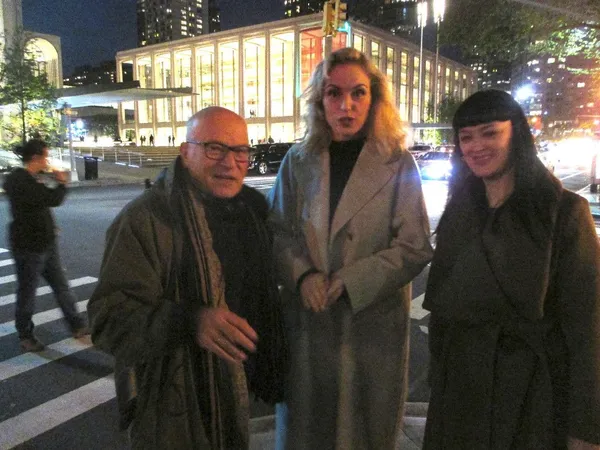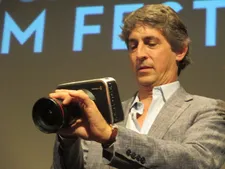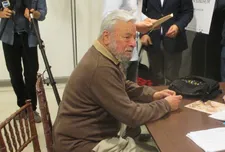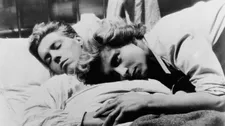 |
| On the Return to Montauk set with Volker Schlöndorff, Nina Hoss (his Barefoot Contessa), and Bronagh Gallagher at Lincoln Center Photo: Anne-Katrin Titze |
Konrad Wolf’s I Was Nineteen (Ich War Neunzehn) co-written with Wolfgang Kohlhaase; Marlen Khutsiev’s It Was In May (Byl Mesyats May) starring Pyotr Todorovskiy; Louis Malle's The Fire Within (Le Feu Follet) based on the novel by Pierre Drieu La Rochelle with Maurice Ronet, Jeanne Moreau and Alexandra Stewart; Joseph Mankiewicz’s The Barefoot Contessa starring Ava Gardner and Humphrey Bogart; Jean-Pierre Melville's Les Enfants Terribles, adapted from Jean Cocteau’s novel with Nicole Stéphane and Édouard Dermit; and Fritz Lang's Spies (Spione) featuring Rudolf Klein-Rogge and Gerda Maurus, are the six films selected by Volker Schlöndorff as Guest Director of the 43rd Telluride Film Festival.
 |
| Michael Curtiz's The Breaking Point was one of Alexander Payne's picks in 2009 Photo: Anne-Katrin Titze |
Alexander Payne, Buck Henry, Stephen Sondheim, Peter Bogdanovich, Bertrand Tavernier, John Boorman, Slavoj Žižek, Laurie Anderson, Don DeLillo, Salman Rushdie, Errol Morris, and Kim Morgan with Guy Maddin are among the past luminaries who curated a program for the festival.
Les enfants terribles will also be shown in the New York Film Festival's retrospective section A Brief Journey Through French Cinema, inspired by Bertrand Tavernier's 2016 documentary My Journey Through French Cinema.
Below are Volker's comments on the films he selected to be screened at this year's festival:
I Was Nineteen - Konrad Wolf’s father, a medical doctor, took him to Moscow when Hitler seized power. He stayed from age 9 to 19, enlisting in the Red Army with his brother Markus (who later became head of the secret service). The film, written with Wolfgang Kohlhaase, is partly based on young Konrad’s diary, in which a young German returns home wearing a Soviet uniform, preparing to fight his former fatherland, which could become his own again … or not. For years, we young filmmakers in West Germany considered this to be the best film to come from the East, despite the interference from DEFA, the state production company, which supervised the script, casting, shooting and editing. - VS (East Germany, 1968, 115m)
 |
| In 2003, Stephen Sondheim opted for Julien Duvivier's La Belle Equipe Photo: Anne-Katrin Titze |
It Was in May - Marlen Khutsiev’s film tells the same story as I Was Nineteen, Red Army penetrating Germany, same locations, same characters, but a different perspective, and [I] have little to add to Naum Kleiman, who just wrote me a letter: “Khutsiev’s film is really one of masterpieces of Soviet and (I'm sure) European cinema. It is practically unknown in the U.S. … Khutsiev kept here the sense of happiness, the most difficult to convey, during half a film. There are few filmmakers, who can do it so naturally, so organically: Robert Flaherty, Jean Vigo, Boris Barnet, Roberto Rossellini, Yasujiro Ozu and Mikio Naruse ... Khutsiev succeeded to bring us the feeling of the end of the war. His friend, the great cinematographer Peter Todorovsky, plays the main role and was a very young man in the war; he remembered his own feelings so exactly and so simply that the victory over the Nazis becomes more a thing of human nature than a military heroism.” - VS (U.S.S.R., 1970, 115m)
The Fire Within - By age 31, Louis Malle had already known major artistic and financial ups and downs, but suffered from a perceived lack of recognition as an auteur within the Nouvelle Vague. So he set out to write an autobiographical screenplay. Then his friend Roger Nimier killed himself on the highway, near the spot where the young renegades of Malle’s film Elevator To The Gallows raced to the sound of Miles Davis’s music. Malle dropped his own story and adapted Drieu La Rochelle’s novel about a 30-year-old killing himself. He modeled the character on himself, using his books, paintings and clothes on set, and casting friends Jeanne Moreau and Alexandra Stewart. For his alter ego he settled on Maurice Ronet, whom he directed with the extreme rigor of an artist painting an unforgiving self-portrait. - VS (France, 1963, 108m)
_225.webp) |
| Sophie Fiennes's Pervert's Guide star Slavoj Žižek was the 2008 Telluride Guest Director Photo: Anne-Katrin Titze |
The Barefoot Contessa - I can’t wait to see Joseph Mankiewicz’s film on a big screen again. I was 16 when I first saw it in my hometown Wiesbaden and it caused a fight with my best friend. He loved it and I thought it was total kitsch. Kitsch or not, Ava Gardner, with her shoes off, haunted me into my 30s, and Humphrey Bogart’s portrait of a director may well have been my role model. I certainly followed his rule never to get involved with the leading lady, and always to go to bed early when directing. Only now, 60 years later, did I dare to make a movie just to celebrate a lady, Nina Hoss, barefoot on a beach. - VS (U.S., 1954, 128m)
Spies - Fritz Lang helped invent all kinds of genres: science fiction (Woman in the Moon And Metropolis), epic adventures (Die Nibelungen), art house (Der Müde Tod), and TV serials. And James Bond is the spawn of his 1928 Spies, with its sex, sin and a super-villain, as well as all kind of technical gimmicks. UFA had lost so much money on Metropolis that Lang wanted to prove he could make a commercial movie on a low budget. Gerda Maurus, straight out of Vienna, was the “virgin actress” who became a star thanks to Lang’s attention and care. And Spies indeed came in on schedule and was a popular success. Critics may have expected more of a “class“ movie, but the unpretentious fun proves Lang’s resourcefulness, his curiosity for Roaring Twenties nightlife in Berlin, and, in every shot, his love for his heroine in every shot. - VS (Germany, 1928, 90m) Live accompaniment by Donald Sosin.
 |
| Édouard Dermit and Nicole Stéphane in Les Enfants Terribles |
Les Enfants Terribles - A literary adaptation by Jean-Pierre Melville? With no gangsters involved? Yes, indeed, his first film, which I saw the same year as Contessa, and indelible for his heroine, played by Nicole Stéphane. (Five years later, on Leon Morin, Priest, he made me “associate director” because according to union rules I was too young to be an assistant.) Melville shot the entire film, adapted from Jean Cocteau’s 1929 novel, by night (though in the studio), because already then he said he hated to get up in the morning. But maybe it was more to achieve the morbid, late-past-midnight atmosphere that this desperate love story, a triangle between a young sister, brother and friend, needed. Love could only end in disaster, Melville advised me, better to stay away from it - as he did in life and in his movies. - VS (France, 1950, 105m)
The 43rd Telluride Film Festival runs from September 2 through September 5.





















